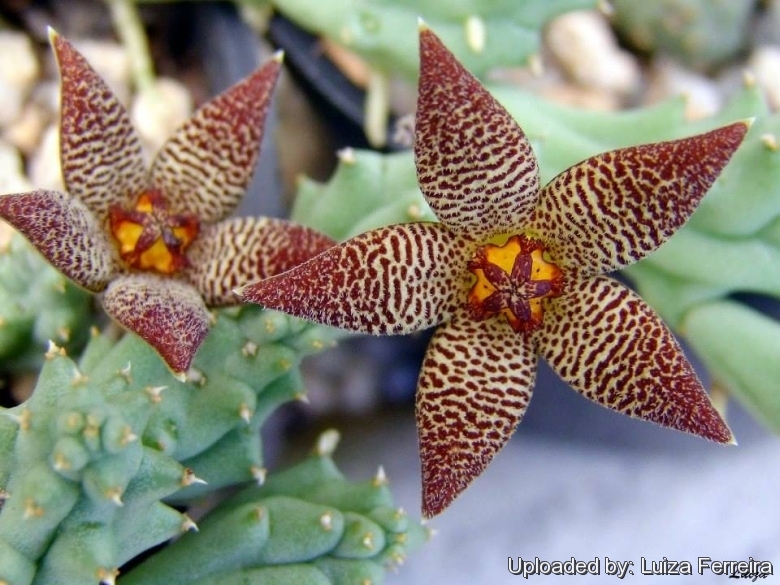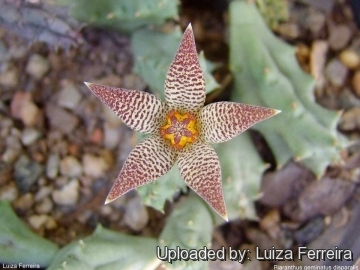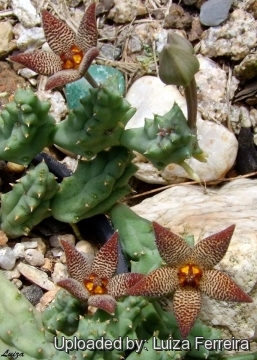Accepted Scientific Name: Piaranthus geminatus (Masson) N.E.Br.
J. Linn. Soc., Bot. 17: 163. 1878 [1880 publ. 1878]

Piaranthus disparilis Photo by: Luiza Ferreira
Origin and Habitat: Cape Province (Central region Laingsburg Div. between Ladismith and Laingsburg) South Africa
Habitat and origin: Piaranthus disparilisSN|18032]]SN|18032]] is found on shales under bushes.
Synonyms:
See all synonyms of Piaranthus geminatus
Description: Piaranthus disparilisSN|18024]]SN|18032]] is a very much smaller morphological or geographical form of the very variable Piaranthus pillansiiSN|30430]]SN|18033]]. It differs in the smaller size and different shape of the corolla-lobes and the markings on the corolla, moreover in regard to its corona P. disparilis resembles P. geminatus but the crest of the corona-lobes is distinctly toothed, not merely minutely tuberculate. Flowers emit an “odour like bad vinegar,” according to Mr. Pillans. Up to the time of the publication of the monograph on the Asclepiadaceae by Dr. N. E. Brown in the "Flora Capensis," this species was only known from collectings of Mr. N. S. Pillans. Piaranthus disparilisSN|18033]]SN|18032]] mentioned in old literature and sometimes offered in plant lists, should be fully synonymized with Piaranthus pillansiiSN|18032]]SN|18033]].
Stems: Creeping, consisting of distinct more or less club-shaped joints, angled, “almost cylindrical, same colour as the flowers” (Pillans) similar to those of Piaranthus comptusSN|18033]]SN|30430]] or Piaranthus geminatusSN|18032]]SN|18024]].
Flowers: 1 to 3 in a short inflorescence, about 18 mm to 20 (or slightly more) mm in diameter, star-shaped, below the tip of stems; pedicels terete, glabrous 6-30 mm long. Sepals 2-3 mm long, lanceolate or ovate, subacuminate, recurved at the tips, glabrous. Corolla rotate, without a distinct tube nor exceding 2-5 mm long. Lobes 8-10 mm long, c. 2 mm broad at the base, lanceolate, acuminate, gradually narrowing upwards, obtuse, convex from the margins being slightly recurved, glabrous on the back, velvety-hairy above, not ciliate, “pale pinkish-purple, finely marked with transverse pale yellow lines” (Pillans). Corona-lobes 1.5 mm long, closely incumbent upon the backs of the anthers and the upper incumbent portion about 0-5 mm long, with the tips very slightly turned up, yellow, without markings, lanceolate or linear-oblong, entire or more or less distinctly 3-toothed at the apex, with the middle tooth much the longest and acute, dorsally produced at the base into a subquadrate crest, truncate and distinctly toothed at the top.
Subspecies, varieties, forms and cultivars of plants belonging to the Piaranthus geminatus group
 Piaranthus barrydalensis Meve: flowers whitish to yellowish with brown-red dots or transverse lines margin recurved. Corona yellow, and red. Distribution: Barrydale in the Little Karoo
Piaranthus barrydalensis Meve: flowers whitish to yellowish with brown-red dots or transverse lines margin recurved. Corona yellow, and red. Distribution: Barrydale in the Little Karoo Piaranthus disparilis N.E.Br.: has smaller corolla-lobes and different markings on the corolla. The crest of the corona-lobes is distinctly toothed, not merely minutely tuberculate. Distribution: Cape Province (Central region Laingsburg Div.)
Piaranthus disparilis N.E.Br.: has smaller corolla-lobes and different markings on the corolla. The crest of the corona-lobes is distinctly toothed, not merely minutely tuberculate. Distribution: Cape Province (Central region Laingsburg Div.)  Piaranthus geminatus (Masson) N.E.Br.: Flowers 13-42 mm in diameter, star-shaped, more or less pubescent, whitish, yellowish, reddish or bright brown, with or without brown-red dots or transverse lines. Corona yellow, unspotted.
Piaranthus geminatus (Masson) N.E.Br.: Flowers 13-42 mm in diameter, star-shaped, more or less pubescent, whitish, yellowish, reddish or bright brown, with or without brown-red dots or transverse lines. Corona yellow, unspotted.  Piaranthus geminatus subs. decorus (Masson) Bruyns: flowers green-yellow with dark red-brown, patches or bands and densely velvety-hairy. inner corona lobes incumbent on the anthers with large and deeply furrowed crests. Distribution: Northern Cape, Western Cape.
Piaranthus geminatus subs. decorus (Masson) Bruyns: flowers green-yellow with dark red-brown, patches or bands and densely velvety-hairy. inner corona lobes incumbent on the anthers with large and deeply furrowed crests. Distribution: Northern Cape, Western Cape. Piaranthus geminatus var. foetidus (N.E.Br.) Meve: Flowers 18 mm to 30 mm in diameter, star-shaped, pubescent, and velvety ivory, to sand coloured, with brown-red dots or transverse lines. Corona yellow to orange.
Piaranthus geminatus var. foetidus (N.E.Br.) Meve: Flowers 18 mm to 30 mm in diameter, star-shaped, pubescent, and velvety ivory, to sand coloured, with brown-red dots or transverse lines. Corona yellow to orange. Piaranthus globosus A.C.White & B.Sloane: The name is due to the stem segments that are ovoid or globose, light green and resemble a mass of tiny potatoes.
Piaranthus globosus A.C.White & B.Sloane: The name is due to the stem segments that are ovoid or globose, light green and resemble a mass of tiny potatoes. Piaranthus pillansii N.E.Br.: flowers 3-4 cm wide, typically greenish yellow, pale yellow or very pale-reddish, without (or with very fine) red spots. Corona yellowish-green.
Piaranthus pillansii N.E.Br.: flowers 3-4 cm wide, typically greenish yellow, pale yellow or very pale-reddish, without (or with very fine) red spots. Corona yellowish-green.- Piaranthus pillansii var. fuscatus N.E.Br.: lobes broad, lanceolate, acuminate, dark purple (or dark crimson?) with very numerous slender irregular transverse and labyrinthine greenish-yellow lines and markings.
- Piaranthus pillansii var. incostans N.E.Br.: lobes densely dotted or transversely marked with light purple on an ochreous ground, sometimes so minutely as to look light pinkish-brown.
Bibliography: Major references and further lectures
1) N. E. Brown “Flora Capensis” Vol 4, page 518, 1909
2) Piaranthus disparilis in. “The Flowering Plants of Africa: A Magazine Containing Coloured Figures with Descriptions of the Flowering Plants Indigenous in Africa” - Volume 12 - Page 448, Botanical Research Institute, Department of Agricultural Technical Services, Republic of South Africa., 1932
 Piaranthus disparilis Photo by: Luiza Ferreira
Piaranthus disparilis Photo by: Luiza Ferreira Piaranthus disparilis Photo by: Luiza Ferreira
Piaranthus disparilis Photo by: Luiza Ferreira Piaranthus disparilis Photo by: Luiza Ferreira
Piaranthus disparilis Photo by: Luiza Ferreira Piaranthus disparilis Photo by: Luiza Ferreira
Piaranthus disparilis Photo by: Luiza FerreiraCultivation and Propagation: Piaranthus disparilisSN|18032]]SN|18032]] is an easy blooming plant when mature that require moderately watering through the growing season but enjoy plenty of water and some fertiliser in hot weather, this helps them to flower freely. Water more sparingly in winter according to temperatures. But, as with most asclepiads, it is unwise to leave them wet in cold weather. Winter care presents no problems at 5°C with plenty of light. Since roots are quite shallow, use a cactus mix or add extra perlite or pumice to regular soil potting soil. A gritty, very free-draining compost is suitable, and clay pots help the plants to dry out between watering.
Sun Exposure: Partial sun or light shade
Pest and diseases: Stapelia species vary in their susceptibility to rotting, but are generally fairly easy to grow, especially if kept pest-free. They are very susceptible to stem and root mealy bugs, and damage from these may well initiate fungal attack. If you do have problems with a stem or with basal rotting, you can reliably isolate the healthy parts, dry them off, and re-root them in moist compost.
Cultural Practices: Re-pot every 2 years
Propagation: Easiest with stem cuttings. Allow cuttings to dry a day before planting. Stems must be laid (Not buried) on gritty compost and will then root from the underside of the stems. It can also be increased from seeds sowing in spring in moist, sandy peat moss.
Potting medium: Since roots are quite shallow, use a cactus mix or add extra perlite or pumice to regular soil potting soil. A gritty, very free-draining compost is suitable, and clay pots help the plants to dry out between watering.















